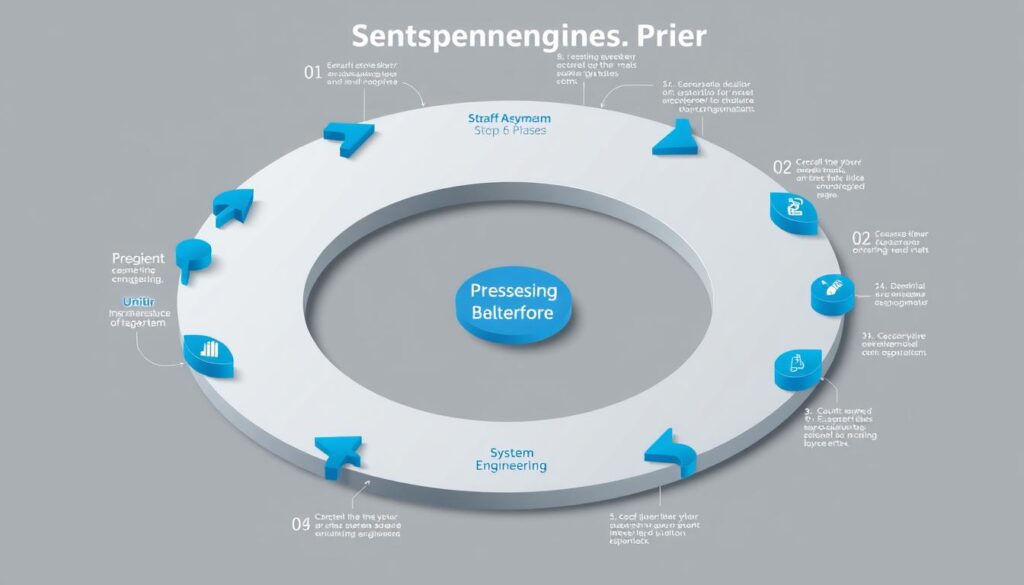In today’s complex and interconnected world, optimizing processes is crucial for organizations to stay competitive.
Systems engineering offers a holistic approach to designing, developing, and maintaining complex systems, enabling businesses to streamline operations and boost efficiency.
By applying systems engineering principles, organizations can drive success and achieve their goals more effectively.
Key Takeaways
- Understanding the importance of systems engineering in process optimization
- Applying holistic approaches to complex system design and development
- Streamlining operations through efficient engineering management
- Boosting efficiency and driving business success
- Achieving organizational goals through system optimization
Understanding the Fundamentals of Systems Engineering
To grasp the essence of systems engineering, it’s essential to explore its fundamental principles and concepts. Systems engineering is a multidisciplinary approach that focuses on designing, managing, and optimizing complex systems throughout their life cycles.
Definition and Core Concepts
Systems engineering is defined as an interdisciplinary approach that integrates various disciplines to develop and manage complex systems. The core concepts include systems thinking, which involves understanding the system as a whole and how its components interact. Other key concepts are requirements management, functional analysis, and system integration. These elements work together to ensure that the system meets its intended purpose and performs optimally.
The table below summarizes the core concepts and their significance in systems engineering:
| Core Concept | Description | Significance |
|---|---|---|
| Systems Thinking | Understanding the system as a whole | Ensures holistic approach to system design |
| Requirements Management | Managing system requirements | Ensures system meets stakeholder needs |
| Functional Analysis | Analyzing system functions | Helps in understanding system behavior |
| System Integration | Integrating system components | Ensures system works as a cohesive unit |
The Evolution of Systems Engineering Practices
Systems engineering practices have evolved significantly over the years, driven by technological advancements and changing organizational needs. Initially focused on technical aspects, systems engineering now encompasses a broader range of disciplines, including management and social sciences. This evolution has led to the development of new methodologies and tools, enhancing the field’s capability to handle complex systems.
The evolution is marked by the integration of model-based systems engineering (MBSE) and the adoption of agile methodologies. These advancements have improved the efficiency and effectiveness of systems engineering processes, enabling organizations to respond more rapidly to changing requirements.
Why Systems Engineering Matters in Today’s Complex World
In an era of increasing complexity, systems engineering emerges as a vital discipline. Modern organizations face a myriad of challenges that are interconnected and multifaceted. To navigate this landscape effectively, a systematic approach is necessary.
Solving Multifaceted Organizational Challenges
Systems engineering provides a framework for addressing complex organizational challenges. By understanding the interdependencies within an organization, systems engineers can identify potential issues before they escalate. This proactive approach enables organizations to mitigate risks and capitalize on opportunities.
The table below illustrates the benefits of systems engineering in addressing organizational challenges:
| Challenge | Systems Engineering Approach | Benefit |
|---|---|---|
| Complexity | Breaking down complex systems into manageable components | Improved understanding and control |
| Interdepartmental Communication | Fostering cross-disciplinary collaboration | Enhanced coordination and reduced errors |
| Risk Management | Identifying and mitigating potential risks | Reduced likelihood of project failure |

Creating Cohesive Solutions Across Disciplines
One of the key strengths of systems engineering is its ability to integrate diverse disciplines. By bringing together experts from various fields, systems engineers can develop cohesive solutions that address the needs of all stakeholders. This interdisciplinary approach ensures that solutions are comprehensive and effective.
For instance, in the development of a new product, systems engineers work with designers, manufacturers, and marketers to create a product that meets customer needs, is producible, and is marketable. This collaborative process results in a product that is more likely to succeed in the market.
Key Principles That Drive Effective Systems Engineering
Systems engineering’s effectiveness is rooted in its foundational principles, which are crucial for navigating complex systems. By embracing these principles, organizations can ensure that their systems engineering efforts are both successful and sustainable.
Embracing Systems Thinking
Systems thinking is a critical component of effective systems engineering. It involves understanding the system as a whole, including its components, interactions, and dynamics. This approach enables engineers to identify potential issues and opportunities that might be overlooked through a more traditional, component-focused lens.
Developing a Holistic Perspective
Adopting a holistic perspective is essential for understanding the complex interactions within a system. This involves considering not just the technical aspects but also the social, economic, and environmental factors that influence the system’s behavior and performance.
Fostering Cross-Disciplinary Collaboration
Cross-disciplinary collaboration is vital for successful systems engineering. By bringing together experts from various fields, organizations can leverage diverse perspectives and expertise to develop more comprehensive and effective solutions.
| Principle | Description | Benefits |
|---|---|---|
| Systems Thinking | Understanding the system as a whole | Improved issue identification, better integration |
| Holistic Perspective | Considering technical, social, economic, and environmental factors | More comprehensive understanding, better decision-making |
| Cross-Disciplinary Collaboration | Bringing together experts from various fields | Diverse perspectives, more effective solutions |
By embracing these key principles, organizations can enhance their systems engineering capabilities, leading to more successful project outcomes and improved overall performance.
Mastering the Systems Engineering Process
To develop efficient and reliable systems, organizations must master the systems engineering process. This process involves several critical steps that ensure the final product meets user needs and is cost-effective.
The systems engineering process is complex and multifaceted, requiring careful planning and execution. It encompasses various activities, from requirements analysis to design synthesis, ensuring that all aspects of the system are considered.
Conducting Thorough Requirements Analysis
Requirements analysis is the foundation of the systems engineering process. It involves gathering and analyzing user needs to define the system’s requirements. This step is crucial in ensuring that the final product meets user expectations.
A thorough requirements analysis involves several key activities, including:
- Identifying user needs and expectations
- Gathering and documenting requirements
- Analyzing requirements for completeness and consistency
As emphasized by a renowned systems engineering expert, “Requirements analysis is not just about gathering data; it’s about understanding the problem you’re trying to solve.”
“The hardest single part of building a software system is deciding precisely what to build.” – Frederick P. Brooks Jr.
Performing Functional Analysis and Allocation
Functional analysis and allocation involve breaking down the system’s requirements into functional components. This step helps to identify the system’s capabilities and allocate them to specific components.
| Functional Component | Description | Allocation |
|---|---|---|
| Component A | Performs task X | Subsystem 1 |
| Component B | Performs task Y | Subsystem 2 |
Implementing Design Synthesis Techniques
Design synthesis involves combining the functional components into a cohesive system design. This step requires careful consideration of the system’s architecture and the interactions between components.
Effective design synthesis techniques include:
- Using model-based systems engineering
- Applying design patterns and principles
- Evaluating design alternatives

By mastering the systems engineering process, organizations can develop systems that are efficient, reliable, and cost-effective. This involves conducting thorough requirements analysis, performing functional analysis and allocation, and implementing design synthesis techniques.
Requirements Management: The Foundation of Successful Systems
The foundation of any successful system lies in its requirements management. This critical aspect of systems engineering ensures that systems are developed to meet user needs and are adaptable to changing circumstances. Effective requirements management involves a systematic approach to eliciting, documenting, and managing requirements throughout the system lifecycle.
Effective Methods for Eliciting Requirements
Eliciting accurate and comprehensive requirements is the first step in successful requirements management. Techniques such as stakeholder interviews, surveys, and workshops are commonly used to gather requirements. It’s essential to involve all relevant stakeholders to ensure that the requirements capture the needs of the users and the system.
- Conduct thorough stakeholder analysis
- Use multiple elicitation techniques
- Document requirements clearly and unambiguously
Building Robust Traceability Frameworks
Traceability frameworks are crucial for linking requirements to design elements, test cases, and validation procedures. This traceability ensures that all aspects of the system are aligned with the original requirements and facilitates impact analysis when changes occur. Building a robust traceability framework involves:
- Establishing traceability matrices
- Linking requirements to design and test artifacts
- Maintaining traceability throughout the system lifecycle
Strategies for Managing Requirement Changes
Managing changes to requirements is an inevitable part of the systems engineering process. Effective change management involves assessing the impact of changes, obtaining stakeholder approval, and updating relevant documentation. Strategies for managing requirement changes include:
- Implementing a formal change control process
- Conducting impact analyses for proposed changes
- Maintaining a history of changes for traceability
By implementing these strategies, organizations can ensure that their systems remain aligned with user needs and are adaptable to changing requirements.
Designing Optimal System Architecture
Crafting an optimal system architecture requires a deep understanding of the system’s requirements and constraints. A well-designed architecture is crucial for ensuring the system’s performance, reliability, and scalability.
Selecting the Right Architectural Framework
Choosing the appropriate architectural framework is a critical step in designing a system. The framework should align with the system’s requirements and facilitate the integration of various components. Popular architectural frameworks include the Zachman Framework, TOGAF, and the Federal Enterprise Architecture Framework (FEAF).

Implementing Proven Design Patterns
Design patterns provide proven solutions to common design problems. By implementing established design patterns, architects can ensure that the system is maintainable, flexible, and scalable. Examples of design patterns include the Microservices Architecture pattern, the Event-Driven Architecture pattern, and the Layered Architecture pattern.
Methods for Evaluating Design Alternatives
Evaluating design alternatives is essential for selecting the most appropriate architecture. This involves analyzing the trade-offs between different design options and assessing their impact on the system’s performance, cost, and maintainability.
Trade-off Analysis Techniques
Trade-off analysis involves evaluating the advantages and disadvantages of different design alternatives. Techniques such as cost-benefit analysis, sensitivity analysis, and decision trees can be used to support trade-off analysis.
Performance Evaluation Criteria
Performance evaluation criteria are used to assess the performance of different design alternatives. Key performance indicators (KPIs) such as response time, throughput, and availability are commonly used to evaluate system performance.
| Design Alternative | Performance | Cost | Maintainability |
|---|---|---|---|
| Option A | High | Medium | Low |
| Option B | Medium | Low | High |
| Option C | Low | High | Medium |
By carefully evaluating design alternatives and selecting the most appropriate architecture, system architects can ensure that the system meets its requirements and is delivered on time and within budget.
Advanced Systems Integration Techniques
In today’s interconnected world, mastering advanced systems integration techniques is vital. As systems become increasingly complex, the need for effective integration strategies grows. Advanced systems integration enables organizations to create cohesive, high-performance systems that meet complex requirements.
Managing Complex Interfaces Effectively
Managing complex interfaces is a critical aspect of systems integration. Complex interfaces can lead to integration challenges, impacting system performance and reliability. To manage these interfaces effectively, it’s essential to identify and document all interface requirements. This involves creating detailed interface control documents and ensuring that all stakeholders are aligned.
Effective interface management also involves implementing robust interface testing and validation procedures. By doing so, organizations can ensure that their systems interact seamlessly, reducing the risk of integration failures.
Developing Integration Plans That Work
Developing an effective integration plan is crucial for successful systems integration. This plan should outline the integration approach, timelines, and resource requirements. It should also identify potential risks and mitigation strategies.
A well-structured integration plan enables organizations to execute the integration process efficiently, minimizing delays and cost overruns. It also ensures that all stakeholders are aware of their roles and responsibilities.
| Integration Plan Components | Description |
|---|---|
| Integration Approach | Defines the methodology for integrating systems |
| Timelines | Outlines the schedule for integration activities |
| Resource Requirements | Identifies the resources needed for integration |
Testing Strategies for Integrated Systems
Testing strategies are vital for ensuring the reliability and performance of integrated systems. There are two primary types of testing: component-level testing and system-level integration testing.
Component-Level Testing
Component-level testing involves verifying that individual system components function as expected. This type of testing ensures that each component meets its requirements and is ready for integration.
System-Level Integration Testing
System-level integration testing involves testing the integrated system as a whole. This type of testing ensures that the system meets its overall requirements and functions as expected.
By implementing these testing strategies, organizations can ensure that their integrated systems are reliable, perform as expected, and meet user needs.
Verification and Validation: Ensuring System Quality
Verification and validation are the cornerstones of quality assurance in systems engineering, ensuring that systems meet the required standards.
To ensure that systems are both reliable and meet user expectations, it’s crucial to understand the processes involved in verification and validation. Verification involves checking that the system is built according to its specifications, while validation ensures that the system meets the user’s needs and expectations.
Choosing the Right Verification Methods
Selecting appropriate verification methods is critical to ensuring that the system adheres to its specifications. Common verification methods include inspection, analysis, and testing. Each method has its advantages and is suited to different types of systems and requirements.
For instance, testing is a widely used verification method that involves checking the system’s functionality against its specifications. This can be done through various types of testing, such as unit testing, integration testing, and system testing.
Implementing Effective Validation Approaches
Validation approaches are designed to ensure that the system meets the user’s needs and expectations. Effective validation involves user testing, where the system is tested with real users to identify any usability issues or functionality gaps.
Another key aspect of validation is requirements validation, which involves checking that the system’s requirements accurately reflect the user’s needs. This can be achieved through techniques such as requirements reviews and prototyping.
Building Quality Assurance into Your Process
Quality assurance is not just about verification and validation; it’s about integrating quality into every stage of the systems engineering process. This involves adopting a quality management approach that encompasses the entire lifecycle of the system.
| Process Stage | Quality Assurance Activity | Outcome |
|---|---|---|
| Requirements Analysis | Requirements Review | Accurate Requirements |
| Design | Design Inspection | Compliant Design |
| Implementation | Code Reviews | High-Quality Code |

By integrating quality assurance into every stage of the systems engineering process, organizations can ensure that their systems are reliable, meet user needs, and are delivered on time and within budget.
Risk Management Strategies in Systems Engineering
Effective risk management is crucial for the success of systems engineering projects. By adopting a proactive risk management approach, organizations can minimize potential risks and ensure the success of their systems engineering endeavors.
Systematic Risk Identification Techniques
Systematic risk identification is the first step in managing risks effectively. Techniques such as Failure Mode and Effects Analysis (FMEA) and Fault Tree Analysis (FTA) are commonly used to identify potential risks. These methods help in understanding the potential failure modes and their impact on the system.
Developing Effective Risk Mitigation Plans
Once risks are identified, developing effective risk mitigation plans is crucial. This involves assessing the likelihood and impact of each risk and devising strategies to mitigate them. Risk prioritization is key, ensuring that the most critical risks are addressed first.
Implementing Continuous Risk Monitoring
Continuous risk monitoring is essential to ensure that risk mitigation plans are effective and to identify new risks as they arise. This involves regular review and update of risk registers, as well as continuous monitoring of project progress against risk metrics.
By integrating these risk management strategies into their systems engineering processes, organizations can enhance their ability to deliver successful projects. Effective risk management not only minimizes potential downsides but also contributes to the overall resilience and reliability of the engineered systems.
Tools and Technologies That Enhance Systems Engineering
The integration of advanced tools and technologies is revolutionizing the field of systems engineering. By leveraging these innovations, organizations can significantly improve their systems engineering practices, leading to more efficient and effective outcomes.
Leveraging Model-Based Systems Engineering
Model-Based Systems Engineering (MBSE) is a powerful approach that involves creating digital models of systems to analyze and optimize their performance. MBSE enables organizations to reduce costs, improve quality, and accelerate the development of complex systems. By using MBSE, engineers can simulate various scenarios, predict potential issues, and make informed decisions early in the development process.
Selecting the Right Requirements Management Tools
Effective requirements management is critical to the success of any systems engineering project. The right requirements management tools can help organizations elicit, analyze, and track requirements throughout the system lifecycle. When selecting a requirements management tool, organizations should consider factors such as ease of use, scalability, and integration with other systems engineering tools.
Using Simulation for System Analysis
Simulation is a valuable technique used in systems engineering to analyze and optimize system performance. By creating virtual models of systems, engineers can simulate various operating conditions, test hypotheses, and predict potential outcomes. Simulation can help reduce the risk of system failures and improve overall system reliability.

Digital twin technology is a type of simulation that involves creating a virtual replica of a physical system. This allows organizations to monitor and analyze the system’s performance in real-time, predict potential issues, and optimize maintenance schedules. Digital twin technology has numerous applications across various industries, including aerospace, automotive, and healthcare.
Predictive Modeling Applications
Predictive modeling is another important application of simulation in systems engineering. By using advanced algorithms and statistical models, engineers can predict potential system failures, optimize system performance, and reduce maintenance costs. Predictive modeling can help organizations make data-driven decisions and improve overall system reliability.
As stated by a renowned expert,
“The use of advanced tools and technologies is crucial for the success of modern systems engineering projects.”
Optimizing Your Systems Engineering Processes
By streamlining systems engineering processes, organizations can achieve greater agility and responsiveness to changing market demands. This is crucial in today’s fast-paced business environment, where the ability to adapt quickly can be a significant competitive advantage.

Conducting Process Assessment and Improvement
The first step in optimizing systems engineering processes is to conduct a thorough assessment of current practices. This involves identifying areas of inefficiency, bottlenecks, and opportunities for improvement. Process assessment can be done through various methods, including audits, surveys, and benchmarking against industry best practices.
Once areas for improvement are identified, organizations can develop and implement plans to address these issues. This may involve streamlining workflows, eliminating unnecessary steps, and adopting new tools and technologies.
Implementing Lean Systems Engineering Principles
Lean systems engineering is a methodology that focuses on eliminating waste and maximizing value in systems development. By applying lean principles, organizations can reduce costs, improve quality, and increase efficiency. Key lean practices include continuous improvement, visual management, and just-in-time production.
Adopting Agile Methodologies in Systems Engineering
Agile methodologies have become increasingly popular in systems engineering due to their flexibility and responsiveness to change. Agile approaches emphasize iterative development, continuous testing, and collaboration between cross-functional teams. By adopting agile methodologies, organizations can improve their ability to respond to changing requirements and deliver value to customers more quickly.
In conclusion, optimizing systems engineering processes is essential for organizations to remain competitive in today’s complex and rapidly changing environment. By conducting process assessments, implementing lean principles, and adopting agile methodologies, organizations can achieve significant improvements in efficiency, quality, and responsiveness.
Real-World Success Stories: Systems Engineering in Action
Real-world examples demonstrate the effectiveness of systems engineering in driving innovation and efficiency. By applying systems engineering principles, organizations across various industries have achieved significant improvements in their processes and outcomes.

Aerospace Industry Transformations
The aerospace industry has seen remarkable transformations thanks to systems engineering. For instance, the development of complex aircraft systems has been streamlined through the application of systems engineering principles. This has led to improved safety, reduced costs, and enhanced performance. Lockheed Martin’s F-35 fighter jet program is a notable example, where systems engineering played a crucial role in integrating various subsystems and ensuring the overall system’s effectiveness.
Healthcare Systems Optimization Case Studies
In healthcare, systems engineering has been instrumental in optimizing systems and improving patient care. Electronic Health Records (EHRs) implementation is a prime example, where systems engineering has facilitated the integration of EHRs with existing healthcare systems, enhancing data accessibility and reducing medical errors. The Department of Veterans Affairs has successfully implemented such systems, leading to more efficient and coordinated care.
IT Infrastructure Modernization Projects
IT infrastructure modernization is another area where systems engineering has delivered significant benefits. By applying systems engineering principles, organizations have successfully modernized their IT infrastructure, achieving improved scalability, security, and performance. For example, Amazon Web Services (AWS) has helped numerous businesses migrate their infrastructure to the cloud, leveraging systems engineering to ensure seamless transitions and optimized resource utilization.
| Industry | Systems Engineering Application | Benefits |
|---|---|---|
| Aerospace | Complex aircraft systems development | Improved safety, reduced costs, enhanced performance |
| Healthcare | EHRs implementation | Enhanced data accessibility, reduced medical errors |
| IT | Infrastructure modernization | Improved scalability, security, and performance |
These case studies illustrate the tangible impact of systems engineering across different domains, demonstrating its potential to drive meaningful change and improvement.
Overcoming Common Challenges in Systems Engineering
Effective systems engineering requires navigating through various obstacles to achieve the desired outcome. As systems become increasingly complex, the need to address common challenges becomes more pressing.
Identifying and Addressing Typical Pitfalls
One of the primary challenges in systems engineering is identifying potential pitfalls early in the process. Poor requirements management and inadequate stakeholder engagement are common issues that can lead to project delays or failures. By recognizing these pitfalls, teams can take proactive measures to mitigate risks.
| Pitfall | Description | Mitigation Strategy |
|---|---|---|
| Poor Requirements Management | Incomplete or inaccurate requirements | Implement robust requirements elicitation and validation processes |
| Inadequate Stakeholder Engagement | Lack of communication with stakeholders | Establish regular stakeholder meetings and feedback loops |
Proven Strategies for Systems Engineering Success
To overcome common challenges, systems engineering teams can adopt several proven strategies. Model-Based Systems Engineering (MBSE) is one approach that has shown significant benefits. By using models to represent system components and interactions, teams can better analyze and optimize system performance.
Another strategy is to foster a culture of collaboration and continuous improvement. This involves encouraging cross-functional teams to work together and share knowledge, as well as regularly assessing and refining processes.
Learning from Past Failures
Despite the best efforts, failures can still occur. However, these failures can provide valuable lessons for future projects. By conducting thorough post-project reviews and documenting lessons learned, teams can identify areas for improvement and develop more effective strategies for overcoming common challenges.

The Future of Systems Engineering: Emerging Trends
Systems engineering is on the cusp of a revolution, driven by digital transformation, AI, and the quest for sustainability. As organizations navigate increasingly complex challenges, the need for advanced systems engineering practices has never been more critical.
The integration of emerging technologies and methodologies is transforming the field, enabling organizations to develop more sophisticated and resilient systems. Digital transformation is at the forefront of this change, leveraging technologies like cloud computing, IoT, and big data analytics to enhance systems engineering capabilities.
Digital Transformation’s Impact on Systems Engineering
Digital transformation is revolutionizing systems engineering by introducing new tools, techniques, and methodologies. For instance, the use of digital twins allows for real-time monitoring and simulation of complex systems, improving their reliability and performance. As noted by a recent report, “Digital twins are becoming increasingly important in systems engineering, enabling organizations to optimize system performance and reduce costs.”
“The use of digital twins in systems engineering represents a significant shift towards more predictive and proactive system management.”
The adoption of digital transformation strategies in systems engineering is not without its challenges. Organizations must navigate issues related to data security, interoperability, and the need for skilled personnel.
Integrating AI and Machine Learning Capabilities
The integration of AI and machine learning into systems engineering is another significant trend. These technologies enable the development of more intelligent and adaptive systems, capable of learning from data and improving over time.
AI-driven tools are being used to automate various aspects of systems engineering, from requirements analysis to system testing. This not only improves efficiency but also reduces the likelihood of human error.

Sustainable and Resilient Systems Engineering Approaches
As concern for the environment grows, the need for sustainable and resilient systems engineering practices is becoming more pressing. This involves designing systems that minimize environmental impact while maintaining their functionality and performance.
Resilient systems engineering focuses on developing systems that can withstand and recover from disruptions. This is achieved through the use of robust design principles, redundancy, and flexible architectures.
By embracing these emerging trends, organizations can ensure that their systems engineering practices are future-proof, enabling them to tackle the complex challenges of tomorrow.
Conclusion
As we have explored throughout this article, systems engineering is a crucial discipline that enables organizations to optimize their processes, drive success, and tackle complex challenges. By understanding the fundamentals of systems engineering, embracing key principles, and mastering the systems engineering process, organizations can create cohesive solutions that meet their needs.
A systems engineering summary highlights the importance of requirements management, designing optimal system architecture, and advanced systems integration techniques. As we look to the future, it’s clear that systems engineering will continue to play a vital role in shaping the world around us. Emerging trends, such as digital transformation, AI, and machine learning, will drive innovation and adaptation in the field.
The future outlook for systems engineering is bright, with opportunities for growth and improvement. By staying informed about the latest developments and best practices, organizations can continue to optimize their processes and drive success. As we move forward, it’s essential to prioritize continued innovation and adaptation in systems engineering to meet the challenges of an increasingly complex world.
